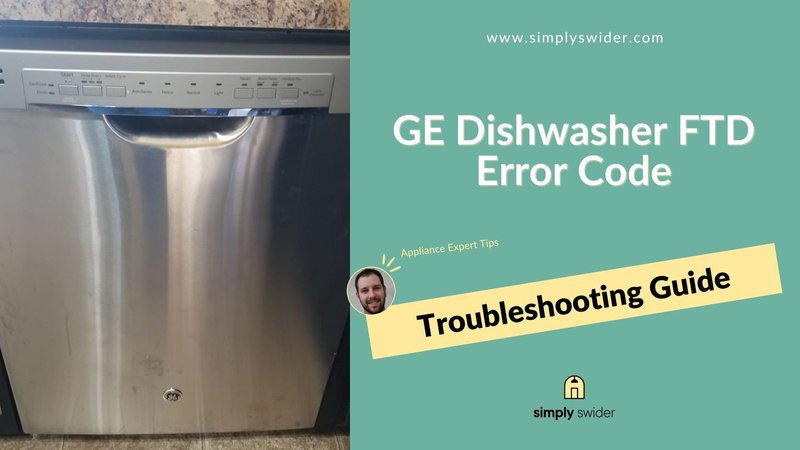
Let’s think of your dishwasher as a small-scale ocean liner navigating through the sea of your kitchen tasks. Error code OE is like a distress signal from the ship’s crew, telling you there’s a problem with the plumbing. Ignoring it might mean getting out your mop to deal with an annoying puddle or worse, calling a plumber. So, before hitting the snooze button on this alert, it’s worth understanding what’s really going on and how you can fix it.
Understanding GE Dishwasher Error Code OE
First things first, let’s decode what the OE error actually means. In the world of GE dishwashers, OE typically signifies an Overflow Error. When your dishwasher flashes this code, it’s literally screaming, “Too much water here!” You can think of it as a bathtub that’s about to spill over. Now, why does this happen? Well, it could be a simple issue, like a blocked drain that’s preventing water from exiting the machine, or a more complex one, like a faulty sensor that’s misreading water levels. Either way, it’s not something to ignore.
Imagine going on a long drive and suddenly, your car’s ‘check engine’ light pops on. Would you just keep driving without a care? Hopefully not, because disregarding it might leave you stranded on the side of the road. The same logic applies here. If your dishwasher’s signaling a problem, addressing it sooner rather than later can save you from potential headaches – and maybe even some repair bills.
What could ignoring it lead to? Well, aside from the possibility of damaging your dishwasher, there’s the risk of a leak. Water that’s not properly drained can spill out onto your floor, causing damage to your kitchen and even leading to mold. It’s like letting a tiny leak in a dam go unchecked – over time, that small leak could turn into a major flood.
Why You Shouldn’t Ignore It
So, what happens if you decide to turn a blind eye to the OE error? Picture this: days roll into weeks, and your dishwasher seems to be working just fine, despite the error flashing each time. However, inside the machine, water continues to build up. Imagine a kettle you keep filling without ever boiling – eventually, it overflows. Similarly, your dishwasher’s malfunction might seem minor now, but it could lead to bigger issues like pump failure or electrical glitches.
Ignoring the problem is like sweeping dust under the rug – it may seem gone, but it’s still there, waiting to cause trouble. Over time, the constant build-up can stress the components, leading to costly repairs or, worse, the need for a new dishwasher altogether. It’s like putting off an oil change in your car. Sure, you can skip it once or twice, but eventually, the engine will suffer.
Worried about costly repairs? Here’s something to ponder: addressing the issue at the first sign of trouble can often lead to a simple fix, like cleaning a filter or checking a clogged hose. These small tasks can often be done yourself, saving both time and money. But if the problem is left unresolved, you may need professional intervention, which could hit your wallet harder than you’d like.
Troubleshooting Steps to Resolve the OE Error
Now that you know why the OE code shouldn’t be ignored, let’s talk about what you can actually do to fix it. Think of it as your dishwasher’s SOS – and you’re the rescuer. Start by checking the drain filter. It’s the gateway for water to exit the machine, much like a drain in your sink. If it’s clogged with food bits or debris, water can’t flow out, and the OE error will appear. So, give it a good clean and see if that helps.
No luck? Next, examine the drain hose. It carries water from the dishwasher to your kitchen drain. If it’s kinked or blocked, it can cause issues similar to a kinked garden hose that can’t water your plants effectively. Straighten it out, or replace it if necessary, to ensure water can flow freely.
Lastly, consider checking the water inlet valve. It’s the gatekeeper for water entering your dishwasher. A faulty valve might not be letting in the right amount of water, causing the overflow error. Replace it if necessary. If these steps seem daunting, don’t hesitate to call in a professional. It’s okay to ask for a little help, particularly if it means getting your trusty dishwasher back on track.
Preventing Future Errors
Once you’ve tackled the OE error, it’s time to think ahead. How can you prevent this pesky problem from cropping up again? For starters, ensure you’re regularly cleaning your dishwasher, focusing on the filter and spray arms. Imagine brushing your teeth – you wouldn’t skip it, because, well, the plaque would build up. The same concept applies here.
Be mindful of what you load into your dishwasher. Large food particles can easily lead to blockages, just like too much hair clogs a shower drain. Scrape off excess food before loading your dishes. It’s a small step that can make a big difference.
Finally, consider running an occasional cycle with a dishwasher cleaner. Think of it as a spa day for your appliance. It helps remove any lingering residue and keeps things running smoothly, reducing the likelihood of errors. By taking these preventative measures, you’re not just maintaining your dishwasher; you’re ensuring a smooth sailing kitchen routine.
In short, while it might be tempting to brush off that OE error, addressing it head-on is your best bet for avoiding bigger issues down the line. A little attention today will save you from hassle tomorrow, keeping your dishwasher – and your kitchen – in tip-top shape.